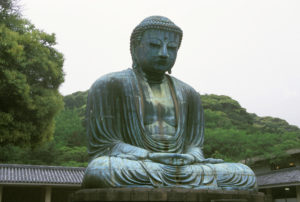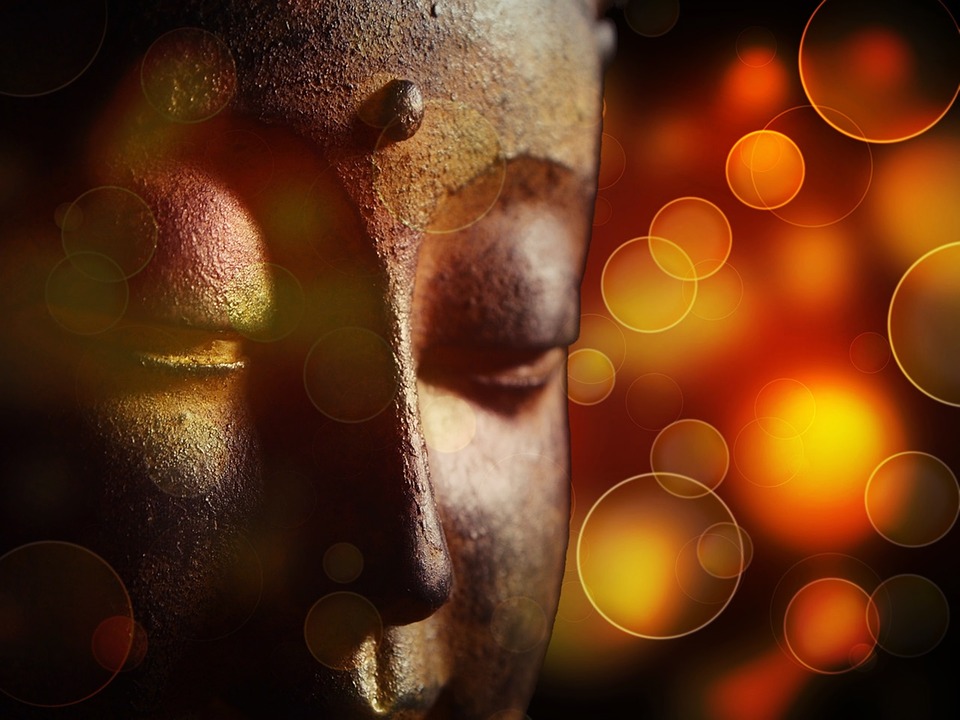Unsatisfactoriness (suffering), impermanence and impersonality (emptiness) Buddha Sakyamuni concluded that these three inescapable factors or “marks” of existence were the common characteristics shared by all phenomena. Often referred to as “the Dharma Seals”, Buddha taught that by bringing theses three factors into awareness, moment-to-moment (mindfulness), we achieve Wisdom the third of the three higher training the way out of the cyclic existence, called Samsara.
This fundamental idea represents a departure from the kinds of thinking that mark the more “religious” spiritual paths and is an approach that is much more closely compatible with modern psychology. As a result, we can often find this approach to be a more effective way for a person to transform and heal their lives. In fact, this is one of the reasons that many of those who are still involved in the traditional Abrahamic religions begin to explore ways in which they can integrate some of the Buddhist ideology into their spiritual practice.
Let’s look at these three inescapable factors of existence, and what they mean for us:
The Buddha taught that nothing found in the physical (phenomenal) world or the realm of psychological can bring lasting deep satisfaction. The word for this unsatisfactoriness in Sanskrit is dukkha, and is often translated as “suffering”. Buddha understood that if one reflects deeply upon the truth of suffering or unsatisfactoriness of all phenomena, they could dispel the illusions (and delusions) they possessed about the world and of life.
Impermanence, called anicca in Sanskrit, refers to the awareness of the fact that all phenomena (including psychology and intelligence) are in a constant state of flux. It also teaches that all phenomena arise out of an ever-changing “cloud” of causes and conditions; thus all conditioned things eventually cease to exist.
 And because nothing in the conditional or phenomenal world is permanent, Buddha understood that the notion of a soul or self was likewise an impermanent phenomenon and illusion. We call this anatta or impersonality. Anatta pervades all of the phenomenal worlds and includes an understanding that our dualistic impressions are delusional. We understand that the “person” we imagine as “me” is not an autonomous, integral entity. The seemingly individual self, or what we might call the ego, is more correctly thought of as a by-product of the five aggregates (form, sensation, perception, mental formations, and consciousness).
And because nothing in the conditional or phenomenal world is permanent, Buddha understood that the notion of a soul or self was likewise an impermanent phenomenon and illusion. We call this anatta or impersonality. Anatta pervades all of the phenomenal worlds and includes an understanding that our dualistic impressions are delusional. We understand that the “person” we imagine as “me” is not an autonomous, integral entity. The seemingly individual self, or what we might call the ego, is more correctly thought of as a by-product of the five aggregates (form, sensation, perception, mental formations, and consciousness).
This can be somewhat confusing to the Western mind, particularly if they still embrace some of the more primitive superstitions about imaginary places, such as heaven or hell. That is because of the Buddhist practitioner, there is no difference between nirvana (liberation) and samsara (cyclic existence).
While the purpose of all spiritual practice can be seen as work undertaken to leave the shores of samsara behind, we also recognize that what we seek is right here.
The difference between liberation and suffering
We say that the difference between liberation and suffering is purely one of perspective. If we are looking at things from the side of suffering, moving toward Enlightenment, then we are following the path of the Sutra, which enjoins us to identify the entire world (internally and externally) as samsara a continual churning of suffering that nobody wants to be part of.
But if we are following the path or perspective of the Vajrayana, we are enjoined to identify the entire world as nirvana a continual play of enlightening activity that everyone wishes to be a part of.
 It’s all just a point of view. Although each of the Three Marks of Existence comprises a topic of Samatha
It’s all just a point of view. Although each of the Three Marks of Existence comprises a topic of Samatha
or meditation/concentration in its own right, conceptually they are interrelated: there is “no-self” because there is “impermanence,” and because there is “impermanence” there is “suffering.”
By better understanding this foundational point in the Dharma path, we are better able to understand that the concept of reincarnation is not quite the idea that many New Age and science fiction accounts refer to = when they use the same term.
What is “reincarnated” is not the “personality” of someone who once lived, but the mental formations (habits) and consciousness known as the fourth and fifth aggregates.
Consider this in one episode of Babylon 5, there was a brilliant observation made by one of the characters, in which we were reminded that you and I are made of the “stuff of the stars”. And while that is scientifically sound, in and of itself, it is also a good metaphor for anatta (no-self).
The Starts in the Skies
Look into the night skies and you will see particular groupings of stars, referred to by certain constellation names. Many of the familiar constellations are given mythological names, such as the stars that comprise the various signs of the zodiac. These groups of stars, when connected by an imaginary line, form different animals, characters, and images.
No one imagines that the stars designated as Aquarius really are a water bearer. And so it is with us. We draw imaginary lines between the elements of form, perception (thought), feelings (emotions), habits and consciousness, and call it “a person”. But from the moment that “person” is born, every single atom from which that “person” is comprised is in a state of flux. Cells die and are replaced. Organs are completely replaced. And with each breath, that “person” is actually in the active state of disintegration, which we call aging until it will eventually cease to exist.
The idea Buddha wanted us to embrace was the idea that we need to look more deeply to change up our perspective. Look deeply, explore reality in your own experience, moment by moment. Find out for yourself. As Ani Pema Chodron puts it, we should recognize impermanence and suffering and egolessness “at the kitchen-sink level”. And she suggests that we learn to celebrate this unsatisfactory quality of all things that we celebrate the constant state of flux that we call impermanence that ultimately, we find joy in our insubstantiality.
In some Buddhist schools of thought, there is a fourth mark of existence one which comes when we have understood the other three
The great dharma teacher, and according to many, the great bodhisattva of the West, who brought the dharma to the people of Palestine, Rav Yeshua (Jesus the Nazarene), is said to have taught: “You are not of this world”
It is by understanding that we are not what we appear to be, and that all things are impermanent, that we encounter that fourth mark of existence: peace.
I wish you peace!





